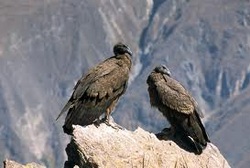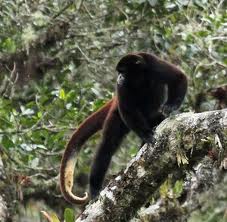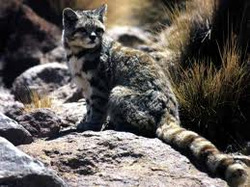The Andean Condor

The Andean Condors are listed as endangered animals in 1973 by the US Fish and
Wildlife Service. They are the most majestic of the birds found in the Andes
Mountains and are found to nest in the mountainous region in the Andean range.
Only a few thousand of them are left in the wild. Hunting for medicinal remedies, deforestation and encroachment of lands, pollution caused due to mining and industrial developments, contamination of food and water, and reduced food supply have caused them to become endangered animals. Moreover, a low reproductive rate has added to their rate of decline.
Wildlife Service. They are the most majestic of the birds found in the Andes
Mountains and are found to nest in the mountainous region in the Andean range.
Only a few thousand of them are left in the wild. Hunting for medicinal remedies, deforestation and encroachment of lands, pollution caused due to mining and industrial developments, contamination of food and water, and reduced food supply have caused them to become endangered animals. Moreover, a low reproductive rate has added to their rate of decline.
Puma

Pumas are threatened by habitat loss, fragmentation, and poaching of their
prey. They are persecuted across their range by retaliatory hunting
due to livestock depredation, and due to fear that they pose a threat to human
life. Sub population, and heavily travelled roads are a major barrier to puma
movements and dispersal resulting in road kills being the number one source of death. Since last recorded the population of the South American Puma is anywhere between 3,500 and 5,000, but the population has been in a state of decline since 1990.
prey. They are persecuted across their range by retaliatory hunting
due to livestock depredation, and due to fear that they pose a threat to human
life. Sub population, and heavily travelled roads are a major barrier to puma
movements and dispersal resulting in road kills being the number one source of death. Since last recorded the population of the South American Puma is anywhere between 3,500 and 5,000, but the population has been in a state of decline since 1990.
Yellow Tailed Wooly Monkey

The Yellow Tailed Wooly Monkey is one of the world's most endangered and rare primate species. It is found only in the Peruvian Andes in altitudes ranging from 4,900 to 8,900 feet. It is believed
that less than 250 of them are left in the wilderness of northern Peruvian cloud
forests. They are fond of eating fruits, leaves, flowers, and
buds. They are categorized as critically endangered because of their fewer numbers. Habitat
loss and cattle-ranching are the main reasons for their endangerment. Economic
development, expansion of agricultural lands, deforestation, logging, and mining
activities has made them endangered animals in Peru.
that less than 250 of them are left in the wilderness of northern Peruvian cloud
forests. They are fond of eating fruits, leaves, flowers, and
buds. They are categorized as critically endangered because of their fewer numbers. Habitat
loss and cattle-ranching are the main reasons for their endangerment. Economic
development, expansion of agricultural lands, deforestation, logging, and mining
activities has made them endangered animals in Peru.
Andean Cat

The declining number of the Andean mountain cats is due to reduction in numbers of their prey.
The harvesting of plants, on which their prey, feed has caused a decline in the
numbers of their prey. Moreover, this endangered animal is hunted by the humans
for traditional ceremonial purposes. In addition to it, they are considered to
bring bad luck, and are therefore killed in Bolivia and Chile. The last survey
in 2008 indicated that there are only 25,000 left in the world
The harvesting of plants, on which their prey, feed has caused a decline in the
numbers of their prey. Moreover, this endangered animal is hunted by the humans
for traditional ceremonial purposes. In addition to it, they are considered to
bring bad luck, and are therefore killed in Bolivia and Chile. The last survey
in 2008 indicated that there are only 25,000 left in the world
Vicuna

The vicuña is a member of the camel family. It is the smallest of the six species of
camel, and is thought to be the wild ancestor of the alpaca. It lives on the
high, grassland plateaus of the Andes mountains which range from southern Peru
to northern Chile and into parts of Bolivia and Argentina. Only tough bunch
grasses and festuca grows here. The sun's ultraviolet rays burn through the thin
atmosphere during the day. At night the heat of the day escapes into the
atmosphere and the temperatures go down to freezing.
The vicuña was almost hunted to extinction for its beautiful soft wool. The Incas
used to round up the wild vicuñas and pen them in stone corrals, where they were
sheared for their wool. In modern times they were almost wiped out for their
meat and wool. By 1960 there were only 6,000 vicuñas left in the wild. Chile and
Peru established protected national parks and put a halt to trade in vicuña
wool. Now there are about 125,000 vicuñas, but they are still listed as
threatened. The vicuña is classified as vulnerable by the IUCN, and as
endangered by the USDI.
Andean Bear

It is highly probable the population of the Andean Bear will go down 30% in a 30 year window, first starting in the 1990's. The loss of habitat continues at a rate of 2-4% per year, and the level of exploitation is thought to be high in many portions of the range. These threats have not ceased, nor is there any indications that they will diminish in the near future. Despite the 20 reservations that have been added in recent years these locations are a mere fraction of the Andean Bears habitat. Moreover, even within protected areas, bears are vulnerable to habitat destruction and poaching because many areas are inadequately patrolled. Road development and the advance of agriculture are particularly insidious because they diminish and fragment habitat, and also attract bears, which are killed through depredation. Increasing mining and oil exploitation pose additional significant threats to this species. Through this decline in in life length and reproduction the estimated population of the Andean Bear is less than 20,000
